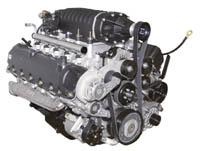FORD POWER PRODUCTS INTRODUCES HYDROGEN INTERNAL COMBUSTION ENGINES TO INDUSTRIAL MARKETPLACE
 Ford 6.8L V-10 H2ICE – Turbocharged |
DEARBORN, Mich., February 24, 2005 – Ford Power Products (FPP), a division of Ford Powertrain Operations, is introducing hydrogen-fueled internal combustion engines (H2ICEs) to the industrial marketplace.
This move parallels Ford Motor Company's introduction of its first commercial hydrogen-powered shuttle bus. The E-450 shuttle bus is equipped with a 26-gallon equivalent, 5,000 pounds-per-square-inch hydrogen fuel tank with an expected range of about 150 miles. A modified 6.8-liter Triton™ V-10 internal combustion engine, that is supercharged and inter-cooled for maximum efficiency, propels the 12-passenger vehicle. With near-zero emissions, the E-450 shuttle bus will meet the most stringent applicable emissions standards. An initial pilot lease program has been established to place pre-production E-450 shuttle buses in target markets.
Ford believes its advanced hydrogen engine technologies will make hydrogen power more practical and support the development of a supporting infrastructure. The company is devoting resources to develop and demonstrate hydrogen vehicle technologies, including hydrogen internal combustion engines.
"These products are coming to market. They are one of the solutions to cleaner air and environment. We have the capability to delve into the marketplace," states Jack Damron, executive director of Ford Power Products. Ford is the only automaker actively involved in all four alternative fuel technologies – gasoline-electric hybrids, clean diesels, hydrogen-powered internal combustion engines and fuel cells.
Ford Power Products is responsible for the sales and marketing of Ford's hydrogen engines. Target industrial applications for prototype hydrogen engines include airline ground support equipment (GSE) and power generation (gen-sets). Production timing and volumes will be dictated by market demand. Original equipment manufacturers or another third party will be responsible for emission certification of the hydrogen engines.
Ford Power Products currently has two different hydrogen engines prototyped in the industrial marketplace. The 4.2-liter V-6 hydrogen engine is prototyped in airline ground support equipment. Hydrogen internal combustion engines deliver up to a 99.7 percent reduction in CO2, making them an ideal power solution within the airport environment where emission levels are strictly regulated. The turbocharged Ford 6.8-liter V-10 hydrogen engine is a natural fit in power generation applications, due to its minimal vibration and wear on engine and gen-set components.
Calibration testing is currently in progress on both hydrogen engines. Preliminary specifications are listed below:
| 4.2L V-6 H2ICE | 6.8L V-10 H2ICE – Turbocharged |
| Fuel: Compressed Gaseous Hydrogen
(CH2) Rated Power: 80 HP (60 kW) @ 3600 RPM Minimum Fuel Pressure @ Engine: 125 psi |
Fuel: Compressed Gaseous Hydrogen (CH2) |
Ford Power Products is the sales and marketing office of Ford Powertrain Operations. Since 1947, FPP has supplied Ford powertrains to the industrial, marine and on-highway markets. Headquartered in Dearborn, Mich., the company also has a European office in Essex, England. For additional information, visit www.fordpowerproducts.com or call 800-833-4773.


